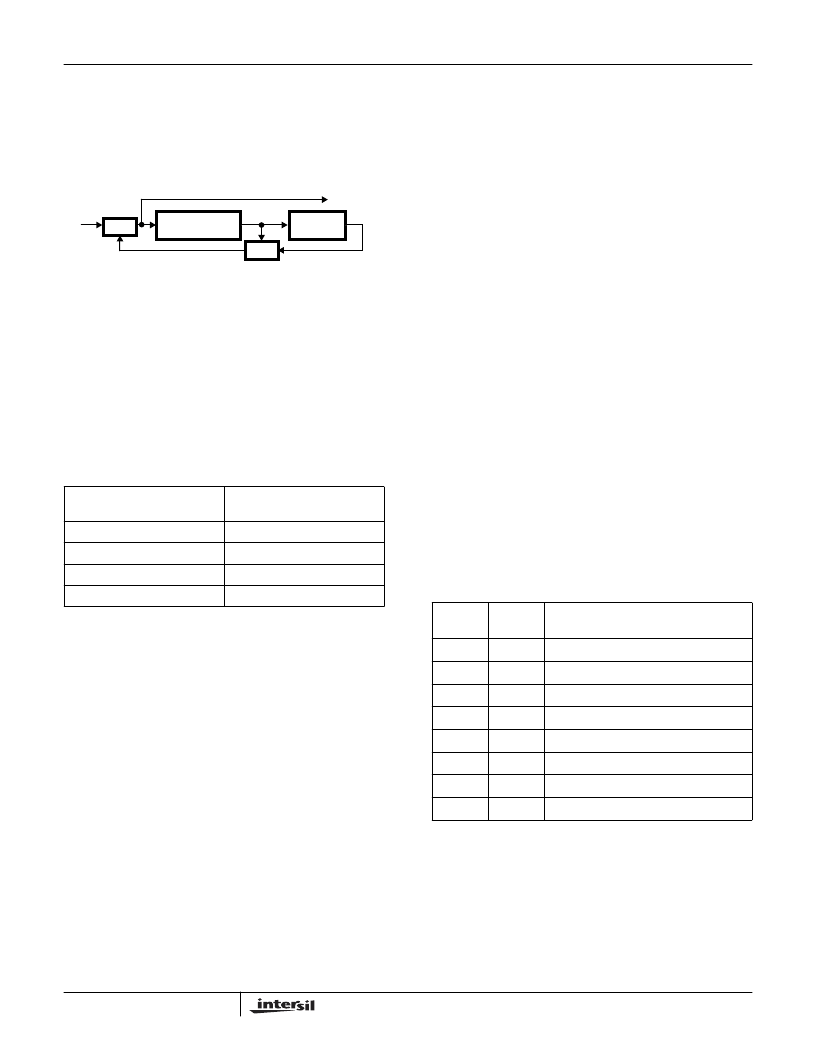- 您现在的位置:买卖IC网 > PDF目录385376 > HFA3860BIV (HARRIS SEMICONDUCTOR) 3.3V 288-mc CPLD PDF资料下载
参数资料
| 型号: | HFA3860BIV |
| 厂商: | HARRIS SEMICONDUCTOR |
| 元件分类: | 无绳电话/电话 |
| 英文描述: | 3.3V 288-mc CPLD |
| 中文描述: | TELECOM, CELLULAR, BASEBAND CIRCUIT, PQFP48 |
| 文件页数: | 15/40页 |
| 文件大小: | 272K |
| 代理商: | HFA3860BIV |
第1页第2页第3页第4页第5页第6页第7页第8页第9页第10页第11页第12页第13页第14页当前第15页第16页第17页第18页第19页第20页第21页第22页第23页第24页第25页第26页第27页第28页第29页第30页第31页第32页第33页第34页第35页第36页第37页第38页第39页第40页

4-15
Scrambling is done by a polynomial division using a
prescribed polynomial as shown in Figure 10. A shift register
holds the last quotient and the output is the exclusive-or of
the data and the sum of taps in the shift register. The taps
are programmable. The transmit scrambler seed is Hex 6C
and the taps are set with CR7.
For the 1MBPS DBPSK data rates and for the header in all
rates, the data coder implements the desired DBPSK coding by
differential encoding the serial data from the scrambler and
driving both the I and Q output channels together. For the
2MBPS DQPSK data rate, the data coder implements the
desired coding as shown in the DQPSK Data Encoder table.
This coding scheme results from differential coding of dibits (2
bits). Vector rotation is counterclockwise although bits 5 and 6
of configuration register CR2 can be used to reverse the
rotation sense of the TX or RX signal if needed.
For data modulation in the MBOK modes, the data is formed
into nibbles (4 bits). For Binary MBOK modulation
(5.5MBPS) one nibble is used per symbol and for
Quaternary MBOK (11Mbps), two are used. The data is not
differentially encoded, just scrambled, in these modes. For
the 5.5Mbps CCK modulation, the data is formed into
nibbles and one is used for each symbol. The symbols are
differentially encoded and all odd symbols are given an
additional 180 degree rotation.
Spread Spectrum Modulator Description
The modulator is designed to generate DBPSK, DQPSK,
BMBOK, QMBOK, and CCK spread spectrum signals. The
modulator is capable of automatically switching its rate
where the preamble and header are DBPSK modulated, and
the data is modulated differently. The modulator can support
date rates of 1, 2, 5.5 and 11Mbps. The programming details
to set up the modulator are given at the introductory
paragraph of this section. The HFA3860B utilizes
Quadraphase (I/Q) modulation at baseband for all
modulation modes.
In the 1MBPS DBPSK mode, the I and Q Channels are
connected together and driven with the output of the
scrambler and differential encoder. The I and Q Channels
are then both multiplied with the 11-bit Barker word at the
spread rate. The I and Q signals go to the Quadrature
upconverter (HFA3724) to be modulated onto a carrier.
Thus, the spreading and data modulation are BPSK
modulated onto the carrier.
For the 2MBPS DQPSK mode, the serial data is formed into
dibits or bit pairs in the differential encoder as detailed
above. One of the bits in a dibit goes to the I Channel and
the other to the Q Channel. The I and Q Channels are then
both multiplied with the 11-bit Barker word at the spread
rate. This forms QPSK modulation at the symbol rate with
BPSK modulation at the spread rate.
For the 5.5MBPS Binary M-Ary Bi-Orthogonal Keying
(BMBOK) mode, the output of the scrambler is partitioned into
nibbles of sign-magnitude (4 bits LSB first). The magnitude
bits are used to select 1 of 8 eight bit modified Walsh
functions. The Walsh functions are modified by adding hex 03
to all members of a Walsh function set to insure that there is
no all 0 member as shown in Table 9. The selected function is
then XOR’ed with the sign bit and connected to both I and Q
outputs. The modified Walsh functions are clocked out at the
spread rate (nominally 11 MCPS). The symbol rate is 1/8th of
this rate. The Differential Encoder output of the last bit of the
header CRC is the phase reference for the high rate data.
This reference is XOR’ed with the I and Q data before the
output. This allows the demodulator to compensate for phase
ambiguity without differential encoding the high rate data.
For the 11MBPS QMBOK mode, the output of the scrambler
is partitioned into two nibbles. Each nibble is used as above
to select a modified Walsh function and set its sign. The first
of these modified Walsh spreading functions goes to the Q
Channel and the second to the I Channel. They are then
both XOR’ed with the phase reference developed from the
last bit of the header CRC from the differential encoder.
TABLE 8. DQPSK DATA ENCODER
PHASE SHIFT
DIBIT PATTERN (D0, D1)
D0 IS FIRST IN TIME
0
00
+90
01
+180
11
-90
10
FIGURE 10. SCRAMBLING PROCESS
Z
-1
Z
-2
Z
-3
Z
-4
Z
-5
Z
-6
Z
-7
XOR
SERIAL DATA
IN
XOR
SERIAL
DATA OUT
TABLE 9. MODIFIED WALSH FUNCTIONS
MAG
mWAL
DATA PATTERN
LSB.......MSB
0
03
11000000
1
0C
00110000
2
30
00001100
3
3F
11111100
4
56
01101010
5
59
10011010
6
65
10100110
7
6A
01010110
HFA3860B
相关PDF资料 |
PDF描述 |
|---|---|
| HFA3860BIV96 | nullDirect Sequence Spread Spectrum Baseband Processor |
| HFA3861BIN | Direct Sequence Spread Spectrum Baseband Processor |
| HFA3861BIN96 | Direct Sequence Spread Spectrum Baseband Processor |
| HFA3925IA | null2.4GHz - 2.5GHz 250mW Power Amplifier |
| HFA3925IA96 | null2.4GHz - 2.5GHz 250mW Power Amplifier |
相关代理商/技术参数 |
参数描述 |
|---|---|
| HFA3860BIV WAF | 制造商:Harris Corporation 功能描述: |
| HFA3860BIV96 | 制造商:Rochester Electronics LLC 功能描述:- Bulk |
| HFA3860IV | 制造商:Rochester Electronics LLC 功能描述:- Bulk 制造商:Harris Corporation 功能描述: |
| HFA3860IV WAF | 制造商:Harris Corporation 功能描述: |
| HFA3860IV96 | 制造商:INTERSIL 制造商全称:Intersil Corporation 功能描述:11 Mbps Direct Sequence Spread Spectrum Baseband Processor |
发布紧急采购,3分钟左右您将得到回复。